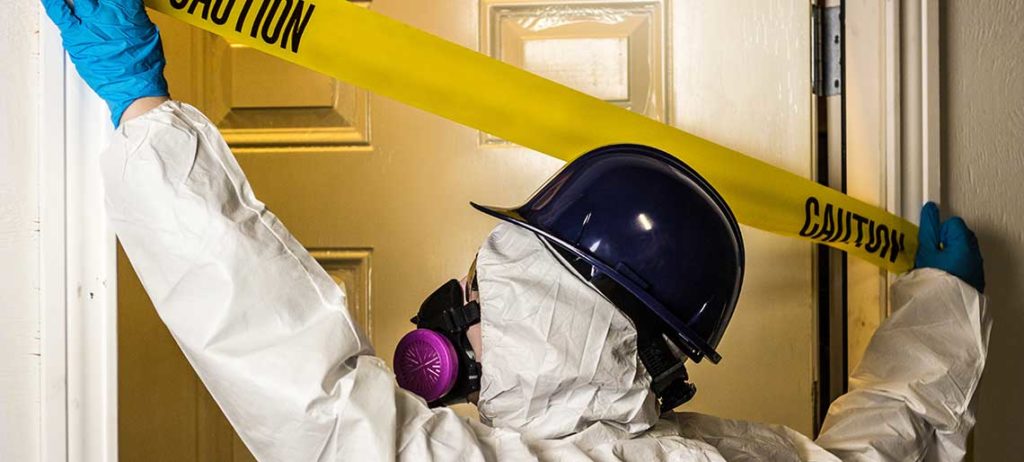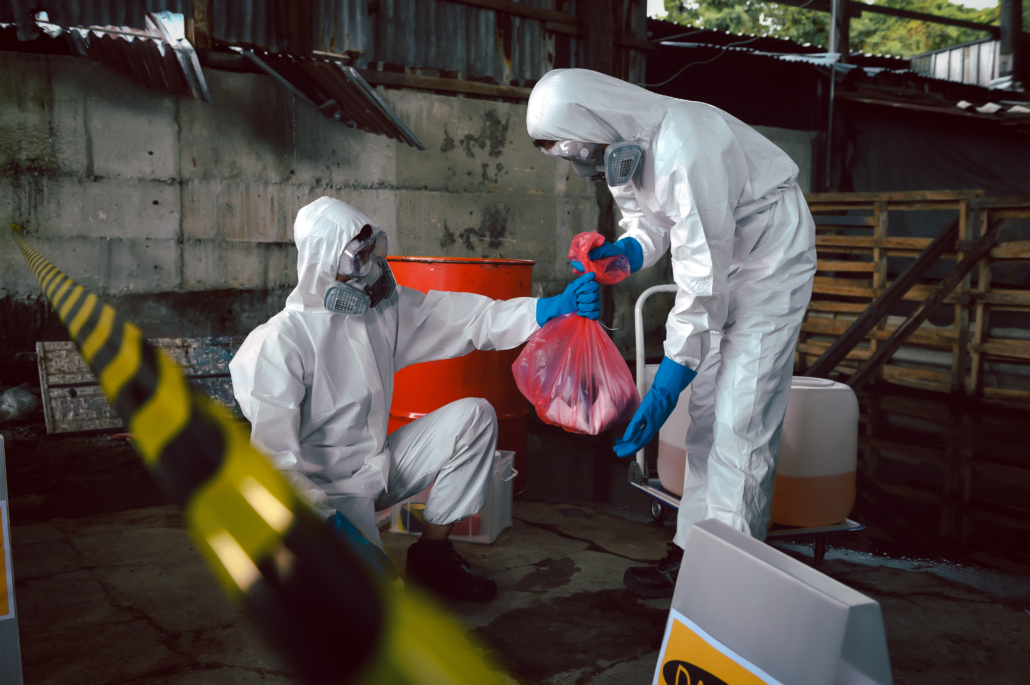Biohazard Removal: Safe Handling and Disposal of Hazardous Materials
Wiki Article
Professional Biohazard Cleaning and Decontamination for Blood, Bodily Fluids, and Hazardous Products
The possible health risks associated with direct exposure to biohazards emphasize the important requirement for precise handling and comprehensive cleaning. As we browse the elaborate landscape of biohazard clean-up, understanding the nuances of laws, compliance, and the customized equipment at play ends up being important in making certain a detailed and secure decontamination process.
Health Threats of Biohazard Exposure
Direct exposure to biohazards poses considerable health threats that can result in severe repercussions for neighborhoods and people alike. Biohazards encompass a variety of organic compounds, including blood, physical liquids, mold and mildew, bacteria, infections, and other potentially infectious products. When individuals enter contact with these biohazards, whether through crashes, incorrect handling, or ecological direct exposure, they face the risk of contracting serious illnesses or diseases.Among the key health dangers connected with biohazard direct exposure is the transmission of transmittable diseases. Bloodborne microorganisms such as HIV, liver disease B and C, and numerous germs can be present in biohazardous materials, positioning a straight danger to human health. Inhaling airborne biohazards like mold spores or entering contact with contaminated surfaces can additionally result in breathing issues, allergic reactions, and various other unfavorable health and wellness impacts.
Additionally, biohazard exposure can have long-lasting wellness effects, with some illness materializing years after the initial call (Blood Cleanup). Consequently, it is crucial to focus on correct biohazard cleaning and purification to alleviate these health and wellness dangers and ensure the safety of people and areas

Specialized Training for Biohazard Cleanup
When it concerns taking care of biohazard cleaning efficiently and securely, specialized training plays a fundamental function in making certain proper purification procedures are complied with. Biohazard cleanup calls for details expertise and skills to properly mitigate threats related to bloodborne pathogens, physical liquids, and hazardous materials. Professionals learnt biohazard cleaning undergo strenuous direction on how to safely deal with, get rid of, and dispose of biohazardous materials to protect against contamination and exposure.Specialized training for biohazard cleaning covers a series of necessary topics, consisting of appropriate personal safety tools (PPE) usage, bloodborne virus understanding, decontamination techniques, and contaminated materials disposal protocols. Individuals learnt biohazard cleaning are geared up with the necessary expertise to analyze contamination degrees, recognize prospective hazards, and implement suitable cleaning procedures in conformity with governing criteria.
Continuous training and education and learning are vital in the area of biohazard cleanup to stay upgraded on the most current decontamination technologies, security procedures, and regulations. By buying specialized training, biohazard clean-up specialists can effectively react to emergency situation cleanup circumstances and guard both public health and wellness and the environment.
Relevance of Proper Decontamination Techniques
Utilizing appropriate purification techniques is vital in biohazard clean-up to properly eliminate dangerous products and lessen health risks. Effective purification not just makes certain the removal of noticeable traces of blood, physical fluids, and other biohazards but additionally targets undetectable pathogens that may posture major health threats if not blood cleaner device properly removed. By complying with stringent decontamination protocols, educated experts can significantly minimize the risk of exposure to dangerous microbes, viruses, and microorganisms that might bring about infections or diseases.Correct purification techniques involve making use of customized tools and disinfectants that are specifically developed to neutralize biohazards efficiently. Extensive cleansing and sanitation of infected locations are essential to stop the spread of pathogens and guarantee a risk-free setting for residents. Additionally, the proper disposal of biohazardous waste adhering to purification procedures is crucial in protecting against contamination of other surfaces or individuals.

Tools and Devices for Safe Clean-up
When dealing with blood, bodily fluids, or harmful products, biohazard cleaning specialists count on specialized equipment to minimize exposure dangers and thoroughly sanitize the afflicted area. Additionally, biohazard cleaning packages having anti-bacterials, absorbent products, and biohazard bags are used to safely get rid of and have of infected things.Advanced cleansing tools like hospital-grade anti-bacterials, HEPA-filtered vacuums, and fogging makers are used to disinfect surfaces and remove biohazards efficiently. Specialized tools such as sharps containers and biohazard garbage disposal containers are utilized to safely handle sharp objects and biohazardous waste materials. By utilizing the appropriate devices and tools, biohazard cleaning professionals can guarantee a detailed clean-up procedure that focuses on safety and security and reduces health dangers for both employees and owners of the damaged area.
Regulations and Compliance in Biohazard Cleaning
Appropriate adherence to laws and compliance criteria is critical in biohazard cleansing to make certain the security of both workers and the setting. Federal government firms such as OSHA (Occupational Safety And Security and Wellness Management) and the EPA (Environmental Security Agency) have actually established particular guidelines for biohazard cleaning procedures to decrease health dangers and environmental contamination. These guidelines cover a variety of aspects including the handling, transportation, and disposal of biohazardous products, in addition to the required training and protective devices needed for employees associated with the cleaning procedure.Biohazard cleaning companies must remain updated with these policies to ensure that their procedures satisfy the required security standards. Failure to abide by try this these laws can cause severe effects, including fines, lawsuit, and threatening the wellness of people and the setting. By complying with rigid regulations and compliance actions, biohazard cleaning companies can efficiently mitigate dangers and make certain a complete and safe clean-up process for all celebrations entailed.
Final Thought
In verdict, biohazard cleaning and decontamination call for specific training, proper strategies, and adherence to guidelines. Exposure to blood, physical fluids, and harmful materials postures considerable health and wellness threats, making it essential to use the right devices and tools for safe cleanup. By following rigorous procedures these details and standards, specialists can efficiently mitigate the dangers connected with biohazard direct exposure and guarantee the safety of both themselves and others.
As we browse the elaborate landscape of biohazard cleaning, recognizing the nuances of guidelines, compliance, and the specific tools at play comes to be critical in ensuring a thorough and risk-free purification process. (Blood Cleanup)
When it comes to managing biohazard cleanup successfully and securely, specialized training plays an essential role in making certain proper decontamination treatments are followed.Utilizing correct purification techniques is crucial in biohazard clean-up to successfully remove dangerous materials and decrease wellness dangers. Additionally, biohazard cleansing sets including disinfectants, absorbent materials, and biohazard bags are utilized to securely include and get rid of of polluted items.
Government agencies such as OSHA (Occupational Safety and Health And Wellness Management) and the EPA (Environmental Defense Agency) have actually established specific guidelines for biohazard cleaning procedures to decrease wellness threats and environmental contamination.
Report this wiki page